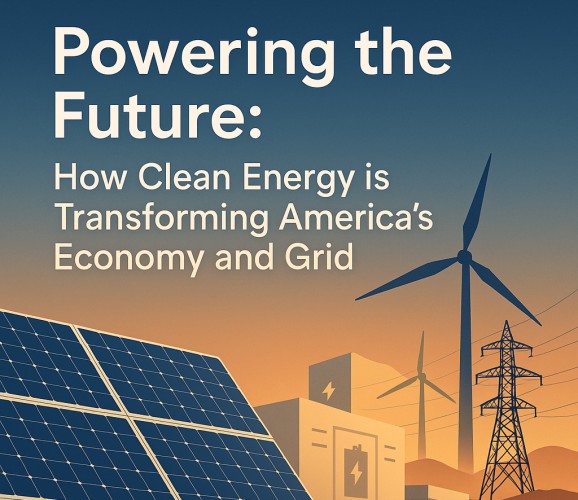Powering the Future: How Clean Energy is Strengthening America’s Economy and Grid
 | Alex Thompson, Communications Associate |

 | Alex Thompson, Communications Associate |
The United States made historic strides in the clean energy sector last year. The Business Council for Sustainable Energy (BCSE) and Bloomberg New Energy Finance's Sustainable Energy in America 2025 Factbook highlights a record-breaking year. In 2024, renewables were responsible for 24 percent of the United States' electricity generation and 93 percent of all energy capacity brought online. Meanwhile, energy storage continues to grow at a blistering pace, albeit at different scales across the country. As more investment flows into the industry, we've already seen the beginnings of what will be another year of significant growth.
Solar and storage remain the rising stars in the energy sector. According to the American Clean Power Association, solar and storage accounted for over 90 percent of clean energy installations in 2024. For the second year in a row, the nation's battery storage capacity nearly doubled, with 11 GW of new capacity brought online. Most of those installations were in Texas and California, with energy storage development still lagging in the Midwest. At CGA, we're working to change that.
Clean Energy is Revitalizing American Manufacturing
Beyond new capacity installations, the clean energy industry is powering an American manufacturing renaissance. With electricity demand facing unprecedented growth over the next decade, strengthening our domestic energy supply chain is crucial to usher in a new era American energy dominance. Clean energy is answering the call. In the last two years, 280 manufacturing projects for primary clean energy components have come online or been announced. Of those projects, 94 have started operations and 186 more are under construction, reopening, or announced.
Subscribe to our newsletter for the latest on energy & our work
The investments driven by clean energy are crucial for America's economic wellbeing. For every $1 spent in manufacturing, there is a total impact of $2.64 to the national economy. With $173 billion invested in clean energy manufacturing, those numbers add up fast. Additionally, the American clean energy industry has added over 100,000 manufacturing jobs in the last two years (on average, manufacturing workers earn over $100,000).
Transmission Infrastructure is Key
We still have work to do, though. The BCSE report repeatedly mentions how transmission-related issues are holding the industry back. New transmission can maximize the value of low-cost, clean energy. Advanced Energy United's Interconnection Scorecard ranks the Midwest Independent System Operator (MISO) at a C- for the efficiency of its generator interconnection process (the process that new projects must go through before coming online). But, it's not all bad news. Recently, MISO announced a historic transmission portfolio known as Tranche 2.1. It may not be a silver bullet, but it's a step in the right direction. Even with massive transmission buildout, there's still a clear need to shorten the wait time in the interconnection queue, which is why CGA is working to identify fast and fair reforms.
The last ten years have been nothing short of transformative for clean energy. In 2014, there were 70,000 MW of online solar, storage, and wind capacity in the United States. Today, that number has more than quadrupled, growing to nearly 300,000 MW (over 50,000 MW comes from CGA's nine-state footprint). Clean energy has solidified its place in electricity generation by pouring billions of dollars into the U.S. economy and delivering clean, affordable, reliable energy to millions of American homes and businesses. The future is bright, and it's being powered by renewable energy.
Other Resources:
Energy Storage Blog
Interconnection Queue Reform Blog
Solar Blog